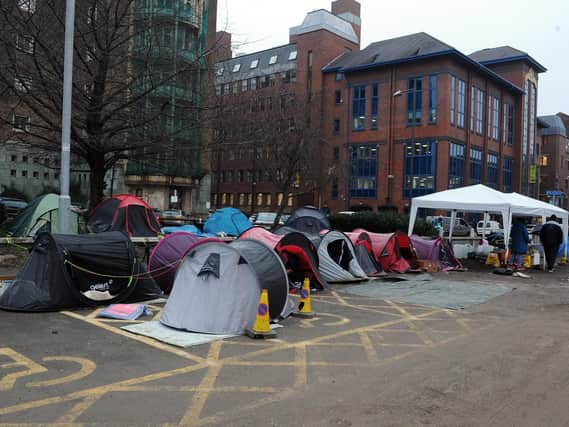The five ways Leeds City Council aims to prevent homelessness and cut rough sleeping


Leeds City Council has released its draft Homelessness and Rough Sleeping Strategy 2018-22, which the authority’s most influential members could sign off at an Executive Board meeting on Wednesday.
The council’s new blueprint has been developed after the Government’s own national Rough Sleeping Strategy was released in August.
Advertisement
Hide AdAdvertisement
Hide AdIt outlines five themes for the city in the next few years: Minimising Rough Sleeping, Maximising Homeless Prevention, the Future Role of Housing Related Support, Youth Homelessness, and a Focus on Priority Groups.
Coun Debra Coupar, the council’s executive member for communities, said: “Leeds is committed to tackling the complex issues around rough sleeping and homelessness. While this will take time, the new strategy lays out how we aim to both meet the challenging government target of significantly reducing the number sleeping rough in the city and build on our successful work preventing homelessness.”
The Government has a target to halve rough sleeping by 2022.
Following a count on one night last November, 33 rough sleepers were found in Leeds.
Minimising Rough Sleeping
Advertisement
Hide AdAdvertisement
Hide AdThrough the Minimise Rough Sleeping theme of the Leeds strategy, the council wants no more than 14 rough sleepers by the same time this year, and no more than eight by 2022.
In a report issued alongside the strategy, the council described these as “extremely demanding targets”, but noted that the Government has pledged £352,000 in 2018/19 for such reductions, with provisionally an extra £385,000 in 2019/20.
There will be a “strong emphasis” on helping people to access mental health and addiction treatment, “the previous absence of which has led to people starting, remaining and returning to sleep rough,” states the report. Fast-tracking people to their own independent tenancies through the Housing First model is also continuing.
Maximising Homeless Prevention
Through Maximising Homeless Prevention, the council will continue giving the same housing need priority to those who are “homeless at home” and living with family or friends as it does to those who are staying at temporary accommodation. This “removes any unnecessary incentive” for such families to use temporary accommodation. Private rented tenancies are also becoming “increasingly important”, with people more willing to accept them pending a move to a council home.
Advertisement
Hide AdAdvertisement
Hide AdThis often allows the person to stay in their area and maintain school and work ties while they wait.
Future Role of Housing Related Support
In the Future Role of Housing Related Support theme, continued collaboration between services such as Housing Options, Beacon, Engage and the Street Support Team launched last year will be key.
The strategy sets out a commitment to look at its supported housing offer to address a “key challenge” of rough sleepers not wanting to use communal emergency accommodation.
Youth Homelessness
Through the Youth Homelessness theme, the partnership between housing services and children’s services is seen as “critical”. Importance is placed on a ‘duty to refer’ scheme, where council workers who suspect someone is at risk of homelessness can flag it up.
Focus on Priority Groups
Advertisement
Hide AdAdvertisement
Hide AdThe Focus on Priority Groups will enable more help for homeless sex workers, young LGBT+ people, domestic violence victims, asylum seekers, refugees and migrants as well as other groups such as veterans.
In numbers
- 11,229 - the number of cases closed at Leeds Housing Options in 2017/18 with 9,180 of those households having the threat of homelessness prevented or relieved. This equates to a prevention/relief success rate of 82%.
- 271 households, for whom the council was unable to prevent/relief homelessness, were accepted as being eligible for assistance, unintentionally homeless and in priority need of a home. The remaining 1,778 cases were not assessed as being owed temporary accommodation, generally because they were not assessed as being ‘vulnerable’
- 29,683 - the number of people who were seen at Leeds Housing Options, sometimes on multiple occasions, in 2018
Advertisement
Hide AdAdvertisement
Hide Ad- 330 - the number of contacts Leeds Housing Options deals with an average per day through footfall at the service, home visits, surgery visits, telephone and email contacts)
- 33 - people found on one night during a rough sleeper headcount in November 2018 - but 130 people are known to services as sleeping rough at some time.
- The number of annual council housing lettings has been reduced from 5214 in 2013/14 to 3657 in 2017/18.
- The average waiting time (across all priority bands) to secure a 1-4 bedroom property has increased from 34 to 54 weeks between 2013/14 and 2017/18
Advertisement
Hide AdAdvertisement
Hide AdThe council says that the "definition of homelessness is distinct and wider than being roofless".
For example, a person could be homeless if they are subject to domestic violence in their mortgaged home, if they are a family whose private landlord is refusing to do essential repairs and is threatening them with reprisal if they complain or a young person who is ‘sofa-surfing’ with different family or friends after a relationship breakdown with parents - the issue is whether it is reasonable to occupy the home, whether they have a legal interest in occupying and whether they will lose the accommodation within 56 days.